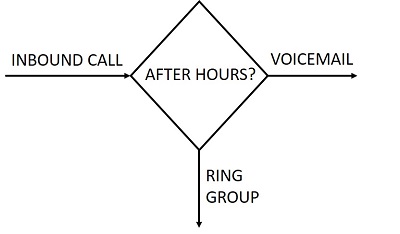Call flows are an integral part of a Private Branch eXchange (PBX) and are very important for inbound business phone calls. In this article we will discuss call flows and how they can be used by businesses to ensure calls are handled efficiently.

What is a Call Flow?
A call flow is simply the path a call takes through your business phone system. In a simple case it may just ring one phone and go to voicemail if there is no answer. In more advanced cases it could go through certain time conditions, followed by an auto attendant and then a ring group for specific departments. Some PBXs also offer a call flow feature, in reality this is really just a feature that adds additional call flow options within an overall call flow process but we will discuss this later in the article too.
Call Flow Use Cases
There are so many different ways you can configure your call flow but let's touch on some of the most popular flows we typically come across.
Ring a phone and if no answer go to voicemail
This is a standard call flow for most residential customers and some very small businesses. Inbound calls are routed to a phone that is registered on the PBX phone system and if after a time period there is no answer the call with route to voicemail for that phone extension. This is a very straightforward call flow.
Ring multiple phones using a ring group
This is very similar to the simple flow above except multiple phones will ring, usually using the ring group feature and whoever answers first wins the call. After a period of time, if there is no answer, go to voicemail. This call flow process is standard for small businesses, with say 2 to 5 employees. The ring group ensures that multiple people can answer an incoming call, those that are already on a call are typically removed from the ring group during this time, unless call waiting is enabled in which case they can switch between calls.
Call are routed through an Auto-attendant
An auto-attendant is a very efficient way to route calls to specific people or departments without the need for a receptionist to answer each call. All inbound calls are answered by the auto attendant which provides the caller with a set of options that determine where the call will flow to next. This could be to specific people (eg press 1 for John, 2 for Ann etc) or to departments (eg press 1 for sales, 2 for support etc). When the options are to specific people the call will route to that persons phone extension only. In the case of departments, the call flow will likely be similar to the ring group option discussed above. Auto attendant call flows are very popular due to their call flow routing efficiency.
Call flows vary based on the day or the time of day
Routing calls based on the day of the week or the time of day or if it is a Company holiday or not is another very popular call flow process. Often an inbound business call will first check the day and time against the time condition feature for that business. If it is during business hours the call may then follow one of the call flows discussed above, such as through an auto-attendant or ring group. If outside business hours the call may be routed to voicemail or forwarded to an after hours call center or an employees cell phone if they are on call during that time.
The Call Flow Feature
Some business providers have a call flow feature inside their phone system. Essentially this is a sub-set of the overall call flow process and is an extra decision box in the call path. One example of this is an after hours over-ride. Let's say a business uses a call flow from the options discussed above but under certain circumstances, for example lunch time or during an all-hands type meeting, the call path has to be routed temporarily to a generic voicemail box. The call flow feature is perfect for this type of scenario as a Busy Lamp Field (BLF) button can be configured on one or more IP phones to act as a call flow over-ride type feature. When this is activated it redirects calls through a different path, such as voicemail, and when de-activated it will return the call path to the standard flow.
Conclusions
In this article we highlighted what a call flow is along with some of the more popular call paths that we typically see. We also touched on the call flow feature, which is available on some PBXs as a manual over-ride to existing call paths.